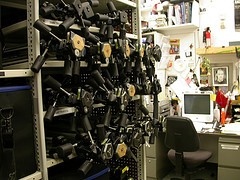This post continues my conversation with outgoing University of the Arts Media Arts Department Chair Harris Fogel. Read Part 1.
[Ed. note: This post has been updated to clarify some factual information.]
R-How about your own photography?
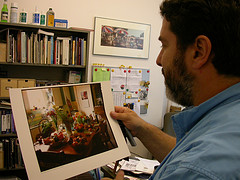
Fogel looking at a print of one of his cibachrome photos. Click to see it big.
H-My latest work was in “International Photo Tage” in Germany. All of that work is large format color work. Two or three years ago I had a large exhibition in California at the Walter Marks Museum.
R-What kind of equipment do you use?
H- I shoot in all formats. I enjoy different formats. I’ve been shooting large (8” x 10”) format color transparencies. …originally they were printed as contact prints on cibachrome. They’re gorgeous to look at because of the color and detail. But cibachrome is poisonous and expensive. I’ve been shooting this way for 20 years. It’s expensive.
R-What do you like about it?
H-I love the finality of the transparency….And now finally I can scan the 8” x 10” transparencies and get results. So I’m remastering my own work. I was a visiting artist this year at the Willson Center, U of Georgia, Athens. I talked about remastering the work.
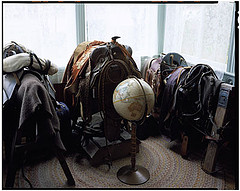
Fogel photo…Globe and horse tackles?
R-Did you print them?
H-Printed them at 12” x 15’ size. I’m not into the super size me generation.
R-What’s your subject matter?
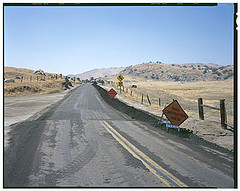
Road picture by Fogel
H-I deal with graphic forms in a wide variety of subjects. american cultures — a series on Howard Finster; water in the west. Water politics is a big part of my book shelves; landscapes, portraits, still lifes.
R-Now that you won’t be chair what’s your plan?
H-I’ll be doing more teaching. Also hopefully be able to concentrate on my own work.
R-Do you have a dark room?
H-I have all the equipment and it’s not set up. I have a lot of photo paper waiting to be printed…

Thomas at an earlier age.
R-How about a dark room in a photography department?
H-There’s still room for darkroom in art schools. It gives the students a base of where photography came from. It makes better digital photographers. Digital is not subtle—you have to work against it. The gold standard is still something produced in the darkroom.
I’ll be teaching color concepts; digital photography workshop; creating artists’ books digitally.
R-What’s coming to the galleries?
H-We’re coming up on our 30 year anniversary of the Sol Mednick Gallery. It was founded by Ray Metzker…The question at the time was was did they need a department chair office or a gallery and he decided on a gallery! It was named for Sol Mednick. It’s the only endowed gallery in town specifically for photography. Traditionally the department chair runs the gallery but I’ll continue to do it (even though he’s no longer department chair). Alida Fish was chair before me. When I became chair I did a summer exhibition. Then we moved to the Terra building and got a new gallery on the 14th floor—1401. The name is an homage to 291, Stiglitz’s gallery in New York.

Carmichael
We have 16 shows a year. Amazing work from around the world. Then five years ago Malcolm Lazin approached me about doing a show for Equality Forum. And now we’re entering our fifth year. We’ve shown David Hilliard and Ryan McGinley, Arthur Tress…So that continues. [Here’s my Weekly review of Arthur Tress. And my post on McGinley/Hilliard. And, heck, here’s the PW review too.]
I’m on the board of Photo Review. For 6 or 7 years I’ve been president of the board.
We take the galleries very seriously.
R-It’s a pretty exciting time to be a photographer in Philadelphia.
H-Photography is on a big resurgence.The scene is real energetic. Gallery 339 is a milestone; the Print Center is great.
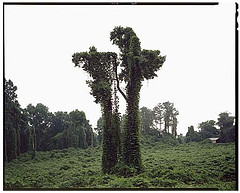
Kudzu
R-Where do you place all your students?
H-Media Arts has a very strong internship program. Alida Fish runs it. She knows everyone and is well respected. Lots of our students go on to work with professionals in the field; in museums. Many stay in the arts. One grad (Shea Roggio) is doing photo-journalism all over the world. He was admitted to the Eddie Adams program in New York.
R-Do you teach from what’s in your galleries?
H-We let the seniors look at who’s submitted and “advise” us, but we do the selections (of who shows in the galleries). Students prep the galleries and I often have my students write reviews. In Media Arts every class must have a writing component. Animation students, for example, have to interview themselves in the style of Animation magazine.
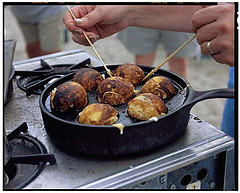
Abelskivers
R-How are the students
H-The sutdents are more professionally prepared. David Graham has taught for us for 8 years. That has helped to prepare them. (he’s both commercial and fine art). They’re very demanding. I’m not a fan of “victims” so our equipment room has everything. They can check it out. The students are much more aware. If you ask them who’s their favorite photographer they might say David La Chapelle. He combines commercial and fine arts. Also, now students can buy, for $1,000 or $1,500 a 20” color printer. You couldn’t do that before.
Photographing the Presidents
R-Tell me about your president’s project, “Photography and the Presidency”
H-I’ve interviewed Presidents Carter, Ford, and Betty Ford and many of the White House staff photographers and directors of the presidential libraries. Someday maybe it’ll be a book. I would like to interview Presidents Bush and Clinton.
R-what are some questions you ask?
H-How does it feel to be followed around by a photographer? Did it influence your presidency?
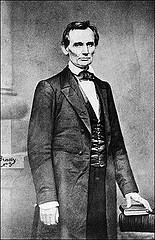
Portrait of Abraham Lincoln (1809-1865), known as the Cooper Institute portrait. Taken by famed photographer Mathew Brady on Feb. 27, 1860, it is one of the few full-length photographs of Lincoln before he became president.
Credit: Corbis
Lincoln said the Cooper Union photo made him appear presidential (Matthew Brady’s photo is referred to as the Cooper Union portrait). Lincoln wrote the first “press pass” to Matthew Brady. It was alleged to have said “Pass Brady” (meaning allow him access to the battlefields, etc).
R-How did you get started on this?
H-It started with David Kennerly at Pepperdine U. My mom worked there when I was in Junior High School and then-President Gerald Ford was visiting. [Kennerly, who won a Pulitzer Prize for his Vietnam War photos was personal photographer to Gerald Ford at the time.] I wanted to take his (Ford’s) picture and my mom asked David Kennerly if he could help me gain access, and he said sure. The project’s been in the works since then.
I’m interested in the impact of images on history. Like the Iwo Jima flag raising image….and like the photo Kennerly took of Bob Dole during the 1992 campaign against Clinton. Kennerly’s photo ran on the cover of Newsweek magazine – in black and white with the headline “Doubts about Dole. As Kennerly put it, the magazine put a negative spin on the photo, which he considerd a very dignified and statesmanlike shot.
It took me 7 years to get my interview with Carter. I wanted an hour but didn’t get that long, but I did get 45 minutes. Carter is himself a photographer.
Did you know the Kennedy archive – President Kennedy’s photo archive – was lost in the World Trade Center/9-11 tragedy. The archive was in a vault in the basement. Everything, including negatives was destroyed. Read about it.


